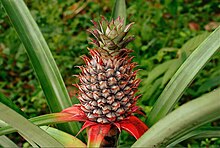Pineapple
| Pineapple | |
|---|---|
 |
|
| A pineapple on its parent plant | |
| Scientific classification | |
| Kingdom: | Plantae |
| (unranked): | Angiosperms |
| (unranked): | Monocots |
| (unranked): | Commelinids |
| Order: | Poales |
| Family: | Bromeliaceae |
| Subfamily: | Bromelioideae |
| Genus: | Ananas |
| Species: | A. comosus |
| Binomial name | |
|
Ananas comosus (L.) Merr. |
|
| Synonyms | |
|
List
|
|
| Nutritional value per 100 g (3.5 oz) | |
|---|---|
| Energy | 209 kJ (50 kcal) |
|
13.12 g
|
|
| Sugars | 9.85 g |
| Dietary fiber | 1.4 g |
|
0.12 g
|
|
|
0.54 g
|
|
| Vitamins | |
| Thiamine (B1) |
(7%)
0.079 mg |
| Riboflavin (B2) |
(3%)
0.032 mg |
| Niacin (B3) |
(3%)
0.5 mg |
| Pantothenic acid (B5) |
(4%)
0.213 mg |
| Vitamin B6 |
(9%)
0.112 mg |
| Folate (B9) |
(5%)
18 μg |
| Choline |
(1%)
5.5 mg |
| Vitamin C |
(58%)
47.8 mg |
| Minerals | |
| Calcium |
(1%)
13 mg |
| Iron |
(2%)
0.29 mg |
| Magnesium |
(3%)
12 mg |
| Manganese |
(44%)
0.927 mg |
| Phosphorus |
(1%)
8 mg |
| Potassium |
(2%)
109 mg |
| Sodium |
(0%)
1 mg |
| Zinc |
(1%)
0.12 mg |
| Other constituents | |
| Water | 86.00 g |
|
|
|
|
|
| Percentages are roughly approximated using US recommendations for adults. | |
The pineapple (Ananas comosus) is a tropical plant with an edible multiple fruit consisting of coalesced berries, also called pineapples, and the most economically significant plant in the Bromeliaceae family.
Pineapples may be cultivated from a crown cutting of the fruit, possibly flowering in 5-10 months and fruiting in the following six months. Pineapples do not ripen significantly after harvest.
Pineapples can be consumed fresh, cooked, juiced, or preserved. They are found in a wide array of cuisines. In addition to consumption, the pineapple leaves are used to produce the textile fiber piña in the Philippines, commonly used as the material for the men's barong Tagalog and women's baro't saya formal wear in the country. The fiber is also used as a component for wallpaper and other furnishings.
The word "pineapple" in English was first recorded to describe the reproductive organs of conifer trees (now termed pine cones). When European explorers discovered this tropical fruit in the Americas, they called them "pineapples" (first referenced in 1664, for resemblance to the pine cone).
In the scientific binomial Ananas comosus, ananas, the original name of the fruit, comes from the Tupi word nanas, meaning "excellent fruit", as recorded by André Thevet in 1555, and comosus, "tufted", refers to the stem of the fruit. Other members of the Ananas genus are often called pine, as well, in other languages. In Spanish, pineapples are called piña ("pine cone"), or ananá (ananás) (for example, the piña colada drink).
The pineapple is a herbaceous perennial, which grows to 1.0 to 1.5 m (3.3 to 4.9 ft) tall, although sometimes it can be taller. In appearance, the plant has a short, stocky stem with tough, waxy leaves. When creating its fruit, it usually produces up to 200 flowers, although some large-fruited cultivars can exceed this. Once it flowers, the individual fruits of the flowers join together to create what is commonly referred to as a pineapple. After the first fruit is produced, side shoots (called 'suckers' by commercial growers) are produced in the leaf axils of the main stem. These may be removed for propagation, or left to produce additional fruits on the original plant. Commercially, suckers that appear around the base are cultivated. It has 30 or more long, narrow, fleshy, trough-shaped leaves with sharp spines along the margins that are 30 to 100 cm (1.0 to 3.3 ft) long, surrounding a thick stem. In the first year of growth, the axis lengthens and thickens, bearing numerous leaves in close spirals. After 12 to 20 months, the stem grows into a spike-like inflorescence up to 15 cm (6 in) long with over 100 spirally arranged, trimerous flowers, each subtended by a bract. Flower colors vary, depending on variety, from lavender, through light purple to red.
...
Wikipedia
